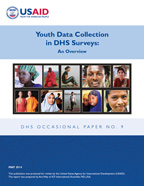- PUBLICATIONS
- JOURNAL ARTICLES
- ACCESS PUBLICATIONS
Publications Summary
- Document Type
- Occasional Papers
- Publication Topic(s)
- Youth
- Language
- English
- Recommended Citation
- Way, Ann. 2014. Youth Data Collection In DHS Surveys: An Overview. DHS Occasional Papers No. 9. Rockville, Maryland, USA: ICF International.
- Download Citation
- RIS format / Text format / Endnote format
- Publication Date
- August 2014
- Publication ID
- OP9
